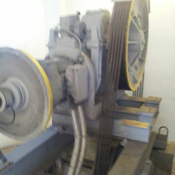Traction Motors & Main Ropes
Geared traction machines are driven by AC or DC electric motors. The electric motor in this design the transmission to this is through a worm-and-gear-type reduction unit, which turns the hoisting sheave. While the lift rates are slower than in a typical gearless elevator, the gear reduction
Characteristic of Gear traction machine.
It required a less powerful motor to turn the sheave when couple to gearless.
These elevators typically operate at speeds from 38 to 152 meters (125-500 ft) per minute
carry loads of up to 13,600 kilograms (30,000 lb).
An electrically controlled brake between the motor and the reduction unit stops the elevator, holding the car at the desired floor level.
Installation in residential buildings and low-traffic commercial applications generally used a single or two speed AC hoist machine.
The availability of cheap solid state AC drives has allowed infinitely variable speed AC motors to be used universally, bringing with it the advantages of the older motor-generator based systems, without the constraint on efficiency and complexity.
Characteristic of Gear traction machine.
It required a less powerful motor to turn the sheave when couple to gearless.
These elevators typically operate at speeds from 38 to 152 meters (125-500 ft) per minute
carry loads of up to 13,600 kilograms (30,000 lb).
An electrically controlled brake between the motor and the reduction unit stops the elevator, holding the car at the desired floor level.
Installation in residential buildings and low-traffic commercial applications generally used a single or two speed AC hoist machine.
The availability of cheap solid state AC drives has allowed infinitely variable speed AC motors to be used universally, bringing with it the advantages of the older motor-generator based systems, without the constraint on efficiency and complexity.

Main Ropes
Traction Motors